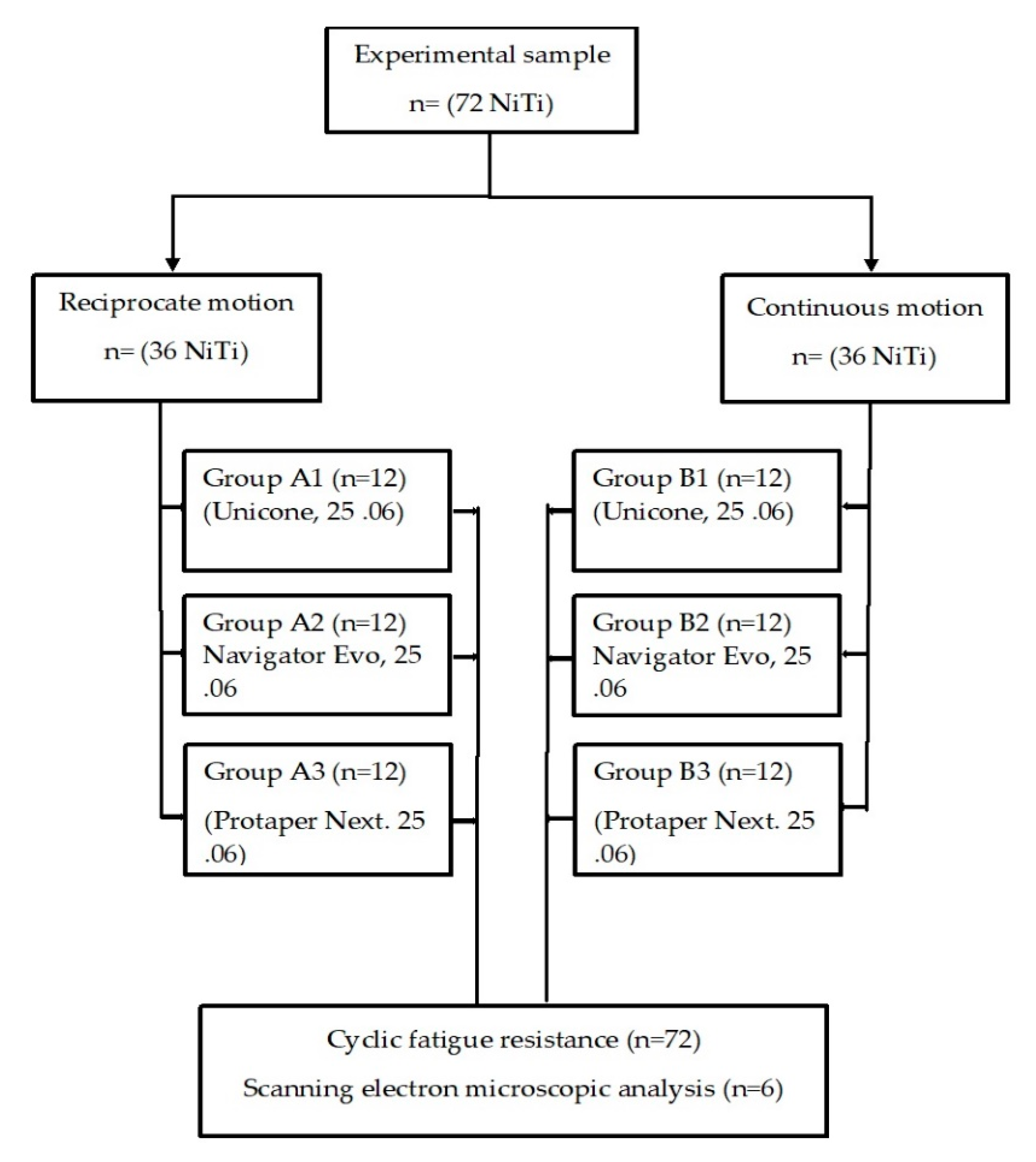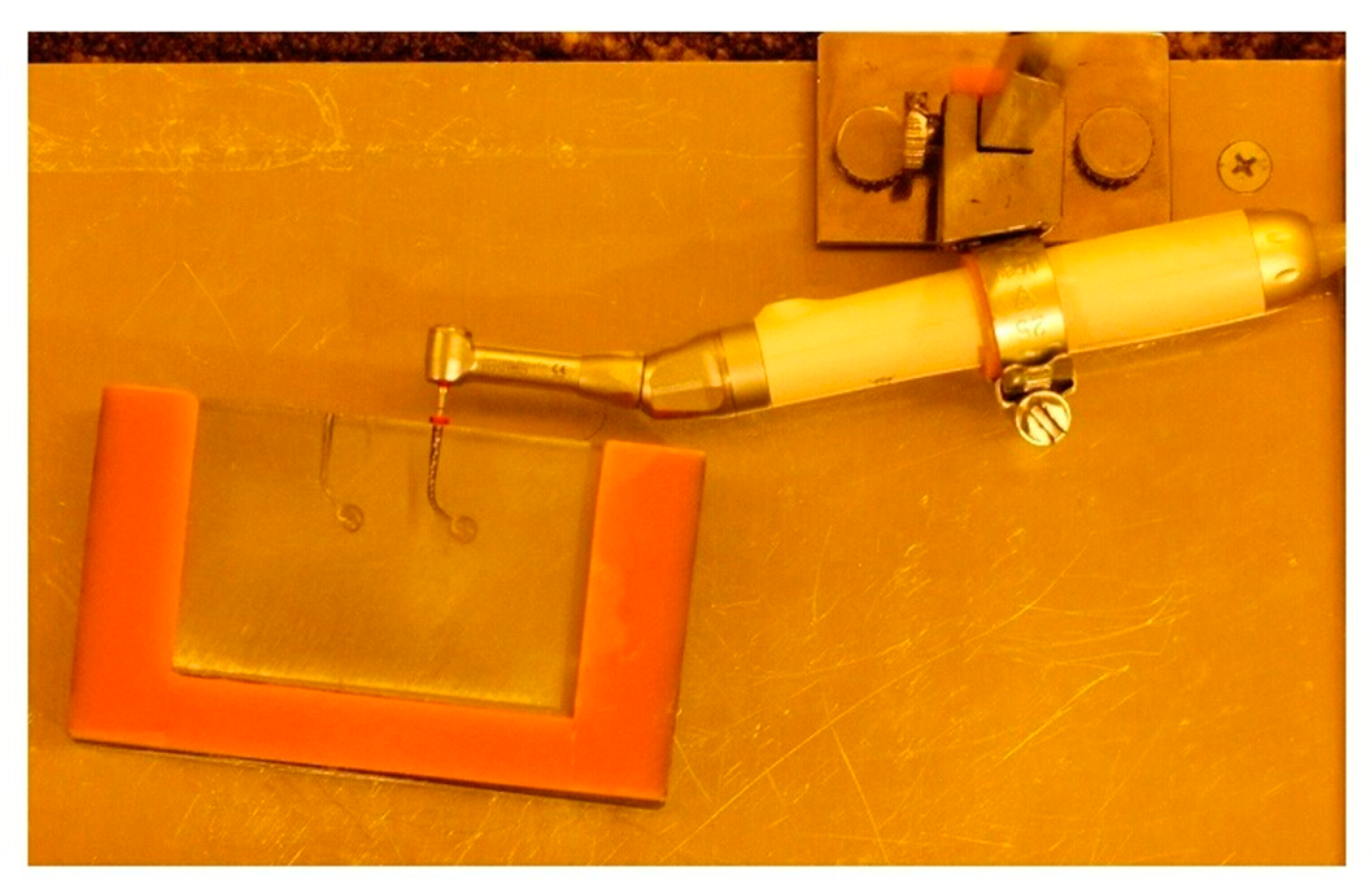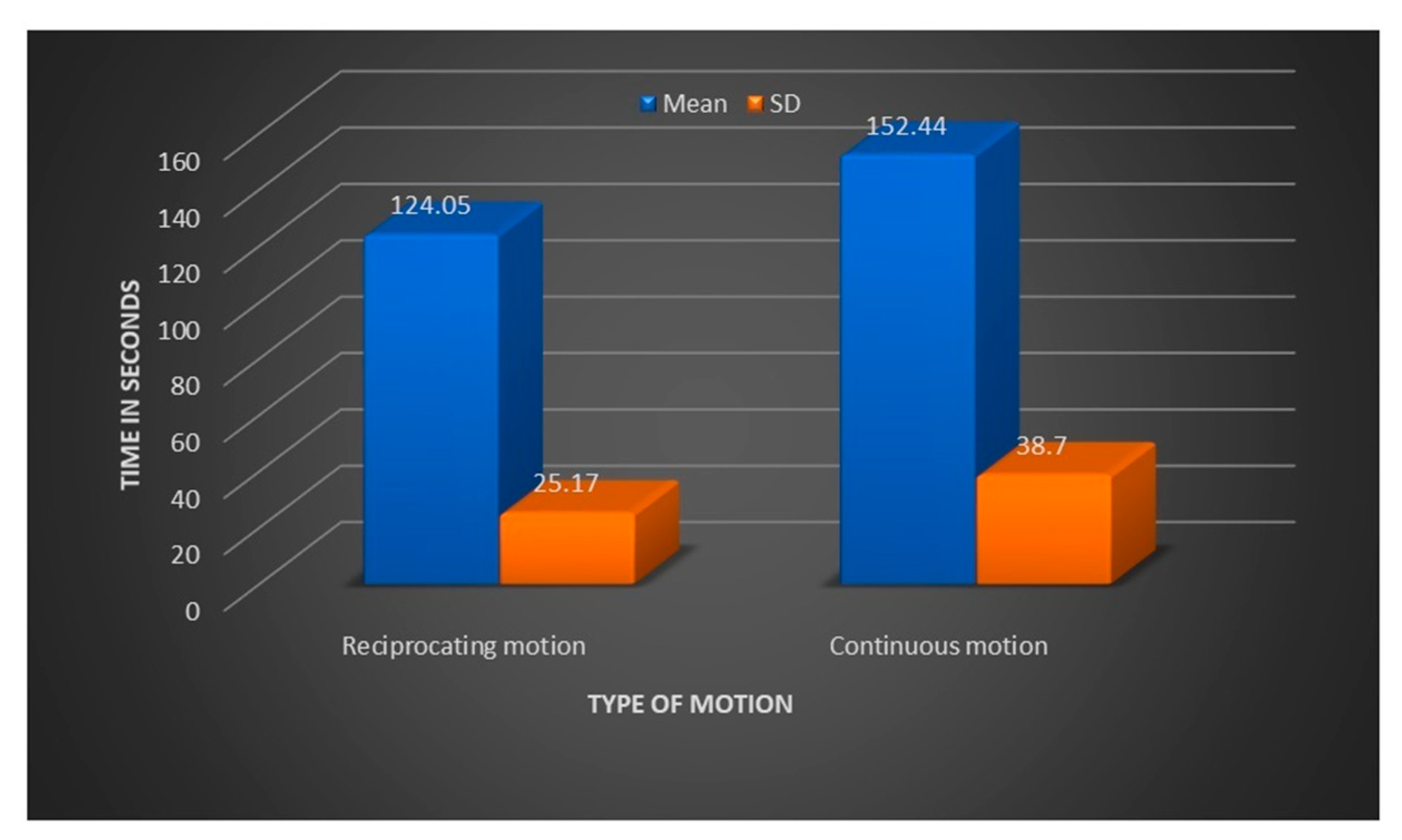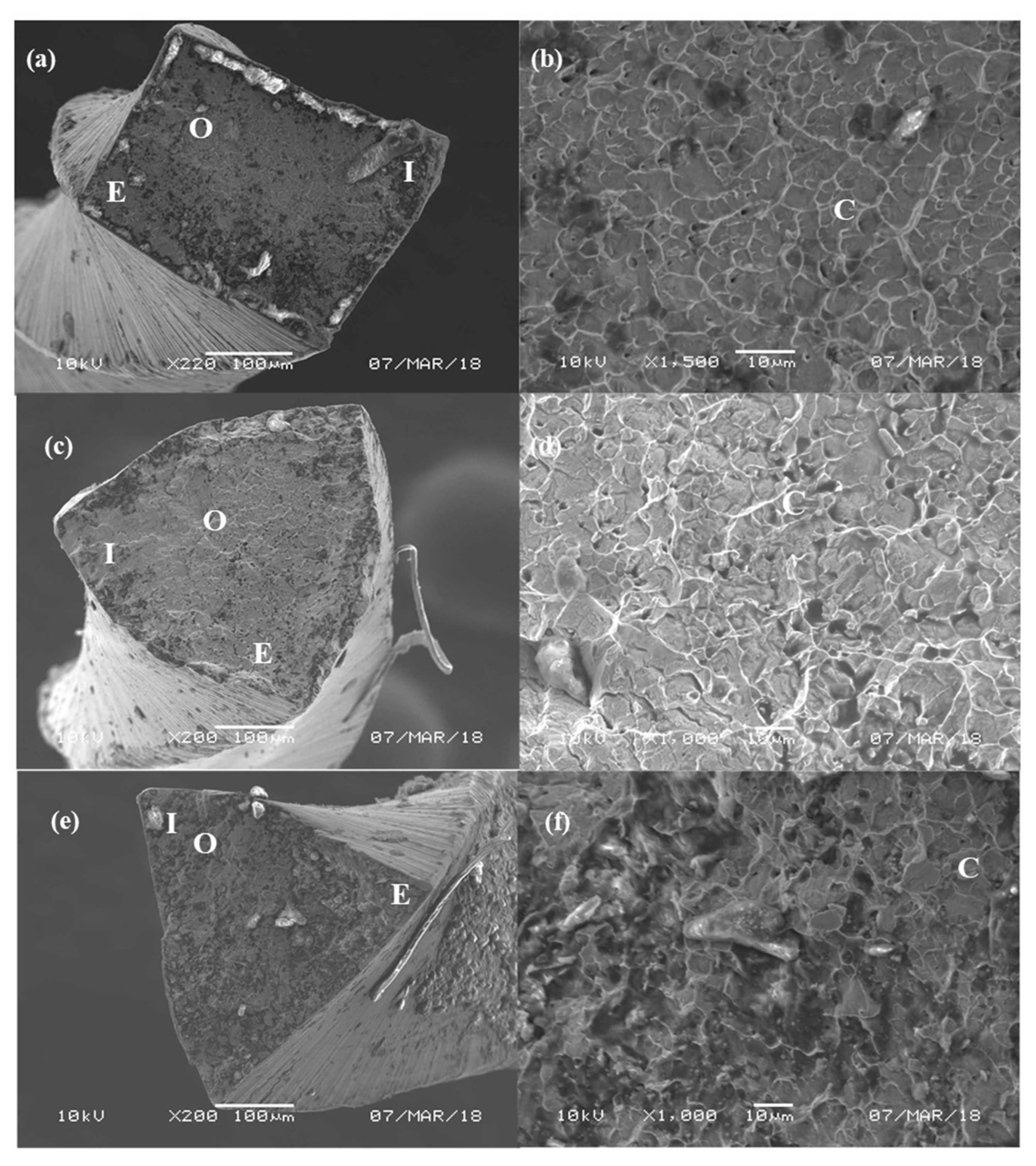Flexural Fatigue of Unicone, Navigator Evo and Protaper Next Files in Reciprocate and Continuous Rotary Systems in Simulated Curved Canals—An In Vitro Study
Abstract
1. Introduction
2. Materials and Methods
2.1. Scanning Electron Microscopy (SEM) Analysis
2.2. Statistical Analysis
3. Results
SEM Evaluation
4. Discussion
5. Conclusions
Author Contributions
Funding
Conflicts of Interest
References
- Lopes, H.P.; Elias, C.N.; Siqueira, J.F., Jr.; Soares, R.G.; Souza, L.C.; Oliveira, J.C.; Lopes, W.S.; Mangelli, M. Mechanical behavior of pathfinding endodontic instruments. J. Endod. 2012, 38, 1417–1421. [Google Scholar] [CrossRef]
- Grande, N.M.; Plotino, G.; Pecci, R.; Bedini, R.; Malagnino, V.A.; Somma, F. Cyclic fatigue resistance and three-dimensional analysis of instruments from two nickel–titanium rotary systems. Int. Endod. J. 2006, 39, 755–763. [Google Scholar] [CrossRef] [PubMed]
- Walia, H.; Brantley, W.A.; Gerstein, H. An initial investigation of the bending and torsional properties of Nitinol root canal files. J. Endod. 1988, 14, 346–351. [Google Scholar] [CrossRef]
- Peters, O.A. Current challenges and concepts in the preparation of root canal systems: A review. J. Endod. 2004, 30, 559–567. [Google Scholar] [CrossRef] [PubMed]
- Gergi, R.; Rjeily, J.A.; Sader, J.; Naaman, A. Comparison of canal transportation and centering ability of twisted files, Pathfile-ProTaper system, and stainless steel hand K-files by using computed tomography. J. Endod. 2010, 36, 904–907. [Google Scholar] [CrossRef] [PubMed]
- Sattapan, B.; Nervo, G.J.; Palamara, J.E.; Messer, H.H. Defects in rotary nickel-titanium files after clinical use. J. Endod. 2000, 26, 161–165. [Google Scholar] [CrossRef] [PubMed]
- Parashos, P.; Messer, H.H. Rotary NiTi instrument fracture and its consequences. J. Endod 2006, 32, 1031–1043. [Google Scholar] [CrossRef]
- Pruett, J.P.; Clement, D.J.; Carnes, D.L., Jr. Cyclic fatigue testing of nickel-titanium endodontic instruments. J. Endod. 1997, 23, 77–85. [Google Scholar] [CrossRef]
- Testarelli, L.; Putortì, E.; Staffoli, S. Cyclic fatigue of NiTi instruments used in complex curvatures with continuous or reciprocating rotation. G. Ital. Endod. 2014, 28, 87–90. [Google Scholar] [CrossRef]
- Larsen, C.M.; Watanabe, I.; Glickman, G.N.; He, J. Cyclic fatigue analysis of a new generation of nickel titanium rotary instruments. J. Endod. 2009, 35, 401–403. [Google Scholar] [CrossRef]
- Uygun, A.D.; Kol, E.; Topcu, M.K.; Seckin, F.; Ersoy, I.; Tanriver, M. Variations in cyclic fatigue resistance among ProTaper Gold, ProTaper Next and ProTaper Universal instruments at different levels. Int. Endod. J. 2016, 49, 494–499. [Google Scholar] [CrossRef] [PubMed]
- Haikel, Y.; Serfaty, R.; Bateman, G.; Senger, B.; Allemann, C. Dynamic and cyclic fatigue of engine-driven rotary nickel-titanium endodontic instruments. J. Endod. 1999, 25, 434–440. [Google Scholar] [CrossRef]
- Dolas, D.R.; Jaybhaye, M.D.; Deshmukh, S.D. Estimation the system reliability using Weibull distribution. Int. Proc. Econ. Dev. Res. 2014, 75, 144–148. [Google Scholar]
- Shen, Y.; Cheung, G.S.; Bian, Z.; Peng, B. Comparison of defects in ProFile and ProTaper systems after clinical use. J. Endod. 2006, 32, 61–65. [Google Scholar] [CrossRef] [PubMed]
- Tripi, T.R.; Bonaccorso, A.; Condorelli, G.G. Cyclic fatigue of different nickel-titanium endodontic rotary instruments. Oral Surg. Oral Med. Oral Pathol. Oral Radiol. Endod. 2006, 102, e106–e114. [Google Scholar] [CrossRef]
- Gambarini, G.; Plotino, G.; Grande, N.M.; Al-Sudani, D.; De Luca, M.; Testarelli, L. Mechanical properties of nickel–titanium rotary instruments produced with a new manufacturing technique. Int. Endod. J. 2011, 44, 337–341. [Google Scholar] [CrossRef]
- Yared, G.M.; Dagher, F.B.; Machtou, P. Cyclic fatigue of Profile rotary instruments after simulated clinical use. Int. Endod. J. 1999, 32, 115–119. [Google Scholar] [CrossRef]
- Yared, G.M.; Dagher, F.B.; Machtou, P. Cyclic fatigue of ProFile rotary instruments after clinical use. Int. Endod. J. 2000, 33, 204–207. [Google Scholar] [CrossRef] [PubMed]
- Li, U.M.; Lee, B.S.; Shih, C.T.; Lan, W.H.; Lin, C.P. Cyclic fatigue of endodontic nickel titanium rotary instruments: Static and dynamic tests. J. Endod. 2002, 28, 448–451. [Google Scholar] [CrossRef]
- Grande, N.; Plotino, G.; Falanga, A.; Somma, F. A new device for cyclic fatigue testing of Niti rotary endodontic instruments. Int. Endod. J. 2005, 38, 936–937. [Google Scholar]
- Tobushi, H.; Nakahara, T.; Shimeno, Y.; Hashimoto, T. Low-cycle fatigue of TiNi shape memory alloy and formulation of fatigue life. J. Eng. Mater. Trans. ASME 2000, 122, 186–191. [Google Scholar] [CrossRef]
- Shen, Y.; Qian, W.; Abtin, H.; Gao, Y.; Haapasalo, M. Effect of environment on fatigue failure of controlled memory wire nickel-titanium rotary instruments. J. Endod. 2012, 38, 376–380. [Google Scholar] [CrossRef] [PubMed]
- de Vasconcelos, R.A.; Murphy, S.; Carvalho, C.A.; Govindjee, R.G.; Govindjee, S.; Peters, O.A. Evidence for reduced fatigue resistance of contemporary rotary instruments exposed to body temperature. J. Endod. 2016, 42, 782–787. [Google Scholar] [CrossRef] [PubMed]
- Nguyen, H.H.; Fong, H.; Paranjpe, A.; Flake, N.M.; Johnson, J.D.; Peters, O.A. Evaluation of the resistance to cyclic fatigue among ProTaper Next, ProTaper Universal, and Vortex Blue rotary instruments. J. Endod. 2014, 40, 1190–1193. [Google Scholar] [CrossRef] [PubMed]
- Gambarini, G.; Grande, N.M.; Plotino, G.; Somma, F.; Garala, M.; De Luca, M.; Testarelli, L. Fatigue resistance of engine-driven rotary nickel-titanium instruments produced by new manufacturing methods. J. Endod. 2008, 34, 1003–1005. [Google Scholar] [CrossRef] [PubMed]
- Cheung, G.S.; Darvell, B.W. Low-cycle fatigue of NiTi rotary instruments of various cross-sectional shapes. Int. Endod. J. 2007, 40, 626–632. [Google Scholar] [CrossRef]
- Elnaghy, A.M. Cyclic fatigue resistance of Pro Taper Next nickel-titanium rotary files. Int. Endod. J. 2014, 47, 1034–1039. [Google Scholar] [CrossRef]
- de Almeida-Gomes, F.; de Matos, H.R.; Nunes, R.F.; Arrais, A.M.; Ferreira-Maniglia, C.; de Morais Vitoriano, M.; Gurgel-Filho, E.D. Cyclic fatigue resistance of different continuous rotation and reciprocating endodontic systems. Indian J. Dent. Res. 2016, 27, 278–282. [Google Scholar] [CrossRef]
- Alcalde, M.P.; Tanomaru-Filho, M.; Bramante, C.M.; Duarte, M.A.; Guerreiro-Tanomaru, J.M.; Camilo-Pinto, J.; Só, M.V.; Vivian, R.R. Cyclic and Torsional Fatigue Resistance of Reciprocating Single Files Manufactured by Different Nickel-titanium Alloys. J. Endod. 2017, 43, 1186–1191. [Google Scholar] [CrossRef]
- Duarte, P.M.; da Silva, P.B.; Alcalde, M.P.; Vivan, R.R.; da Rosa, R.A.; Duarte, M.A.; Só, M.V. Canal Transportation, Centering Ability, and Cyclic Fatigue Promoted by Twisted File Adaptive and Navigator EVO Instruments at Different Motions. J. Endod. 2018, 44, 1425–1429. [Google Scholar] [CrossRef]







| Type of Motion. | Files (Test Groups) | Statistics | |||
|---|---|---|---|---|---|
| Reciprocating | Unicone (A) | N-Evo (B) | PTN (C) | P § | Mean Difference between groups ¶ |
| Fragment Length (mm) | 4.03 ± 0.2 | 3.79 ± 0.2 | 3.63 ± 0.33 | 0.001 | [A–C] |
| Time (sec) | 109.5 ± 25.05 | 118.17 ± 19.45 | 144.5 ± 16.91 | 0.001 | [A–C, B–C] |
| Continuous motion | Unicone (D) | N-Evo (E) | PTN (F) | P § | Mean Difference between groups ¶ |
| Fragment Length (mm) | 3.87 ± 0.21 | 3.75 ± 0.29 | 3.74 ± 0.26 | 0.417 | - |
| Time (sec) | 162.75 ± 36.35 | 182.08 ± 18.77 | 112.5 ± 16.69 | <0.001 | [D–F, E–F] |
| NCF | 434 ± 96.95 | 485.56 ± 50.06 | 562.5 ± 83.46 | 0.001 | [D–F] |
| Variables | Motion | Files | Mean | Standard Error of Mean | t | p† |
|---|---|---|---|---|---|---|
| Fragment length (mm) | Reciprocating | Unicone | 4.03 ± 0.20 | 0.06 | 2.017 | 0.056 |
| Continuous | Unicone | 3.87 ± 0.21 | 0.06 | - | - | |
| Reciprocating | N-Evo | 3.79 ± 0.20 | 0.06 | 0.400 | 0.693 | |
| Continuous | N-Evo | 3.75 ± 0.29 | 0.08 | - | - | |
| Reciprocating | PTN | 3.62 ± 0.32 | 0.09 | −0.934 | 0.360 | |
| Continuous | PTN | 3.74 ± 0.25 | 0.07 | - | - | |
| Time (seconds) | Reciprocating | Unicone | 109.50 ± 25.05 | 7.23 | −4.178 | 0.000 |
| Continuous | Unicone | 162.75 ± 36.35 | 10.49 | - | - | |
| Reciprocating | N-Evo | 118.17 ± 19.45 | 5.61 | −8.191 | 0.000 | |
| Continuous | N-Evo | 182.08 ± 18.77 | 5.42 | - | - | |
| Reciprocating | PTN | 144.5 ± 16.90 | 4.88 | 4.665 | 0.000 | |
| Continuous | PTN | 112.5 ± 16.69 | 4.81 | - | - |
| Groups | N | Mean | Standard Deviation | Weibull Modulus | R-Squared | Predicted Time for 50% Failure Rate |
|---|---|---|---|---|---|---|
| Reciprocating Unicone | 12 | 109.50 | 25.05 | 4.9044 | 0.9117 | 110.24 |
| Reciprocating Navigator Evo | 12 | 118.17 | 19.45 | 7.3543 | 1.00 | 119.96 |
| Reciprocating Protaper Next | 12 | 144.50 | 16.91 | 9.3402 | 0.9011 | 145.63 |
| Continuous Unicone | 12 | 162.75 | 36.35 | 4.6349 | 0.9328 | 165.58 |
| Continuous Navigator Evo | 12 | 182.08 | 18.77 | 10.646 | 91.33 | 183.88 |
| Continuous Protaper next | 12 | 112.50 | 16.69 | 7.1813 | 0.8562 | 114.02 |
© 2019 by the authors. Licensee MDPI, Basel, Switzerland. This article is an open access article distributed under the terms and conditions of the Creative Commons Attribution (CC BY) license (http://creativecommons.org/licenses/by/4.0/).
Share and Cite
Alqahtani, S.; Al-Omari, M.; Olarinmoye, A.O.; Alrahlah, A. Flexural Fatigue of Unicone, Navigator Evo and Protaper Next Files in Reciprocate and Continuous Rotary Systems in Simulated Curved Canals—An In Vitro Study. Metals 2020, 10, 23. https://doi.org/10.3390/met10010023
Alqahtani S, Al-Omari M, Olarinmoye AO, Alrahlah A. Flexural Fatigue of Unicone, Navigator Evo and Protaper Next Files in Reciprocate and Continuous Rotary Systems in Simulated Curved Canals—An In Vitro Study. Metals. 2020; 10(1):23. https://doi.org/10.3390/met10010023
Chicago/Turabian StyleAlqahtani, Saeed, Mohammad Al-Omari, Ayodeji Oluwadare Olarinmoye, and Ali Alrahlah. 2020. "Flexural Fatigue of Unicone, Navigator Evo and Protaper Next Files in Reciprocate and Continuous Rotary Systems in Simulated Curved Canals—An In Vitro Study" Metals 10, no. 1: 23. https://doi.org/10.3390/met10010023
APA StyleAlqahtani, S., Al-Omari, M., Olarinmoye, A. O., & Alrahlah, A. (2020). Flexural Fatigue of Unicone, Navigator Evo and Protaper Next Files in Reciprocate and Continuous Rotary Systems in Simulated Curved Canals—An In Vitro Study. Metals, 10(1), 23. https://doi.org/10.3390/met10010023






